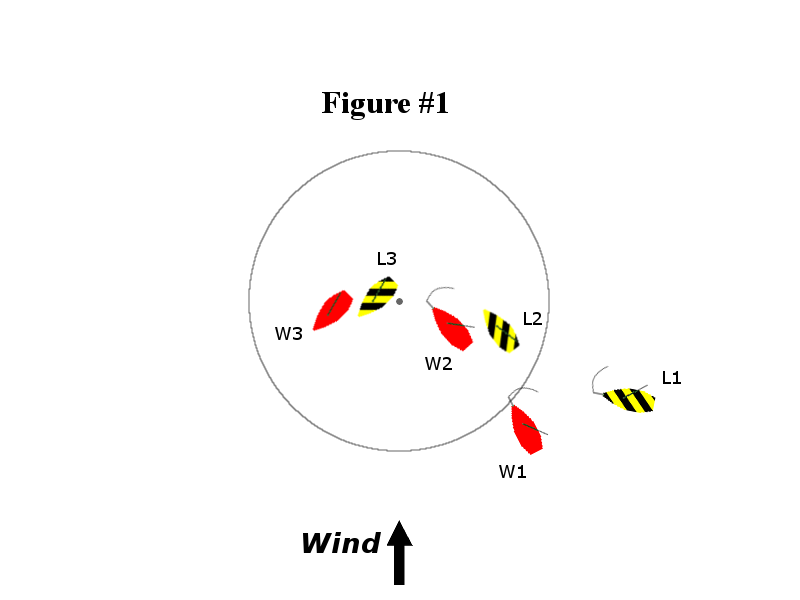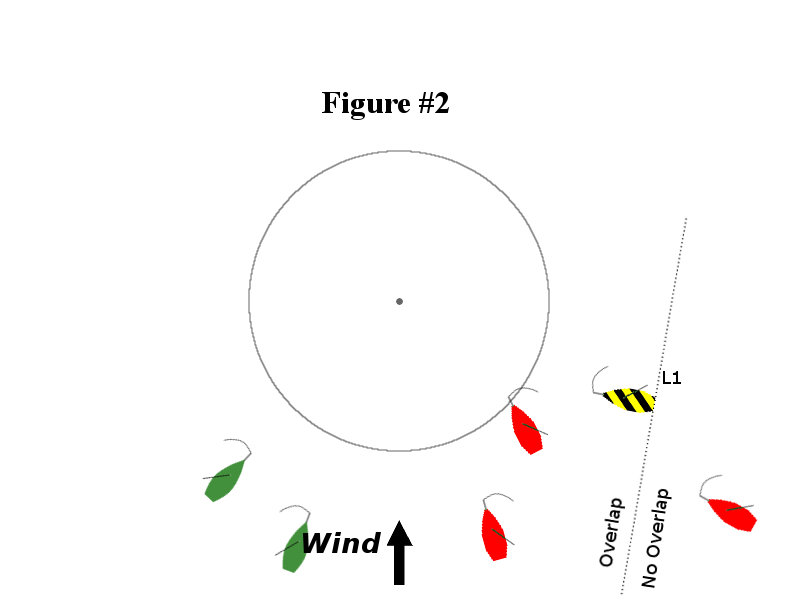
|
This is the LWSA pre-2017 ARCHIVE site. For 2017 and later see the current LWSA site.
Sailing in the Zone, Part Two
At the Leeward Mark on the Same Tack and Overlapped
by Edward Baker
Introduction
In part one of this series we looked at a port tack approach to the leeward mark while in an overlap situation with another boat to leeward (see figure #1). Specifically we emphasized that the windward boat W still had to keep clear of L even though it had mark-room. W's mark-room allowed it only enough room to sail directly to the mark; W could not perform a tactical rounding due to it's obligation to keep clear of L. For part two of the series I would like to use the same situation and look a L's tactical approach to the mark.
Situation
 W and L have been sailing on the downwind leg of a windward-leeward course as shown
in figure #1. At position 1, L is sailing high of the mark as W just
enters the zone. L stays on this high course until after it has entered
the zone at which time it alters course to the right giving W
room to round the mark. L commenced it's gennaker take down just
after entering the zone and before W commences it's gennaker douse.
As a result of it's early douse L's loss of boat speed is sufficient to allow it
to fall clear astern of W as W round the mark. L rounds
the mark behind W and is able to shoot the gap between W's transom
and the mark. As both boats leave the leeward mark
astern L has gained the windward edge over W.
W and L have been sailing on the downwind leg of a windward-leeward course as shown
in figure #1. At position 1, L is sailing high of the mark as W just
enters the zone. L stays on this high course until after it has entered
the zone at which time it alters course to the right giving W
room to round the mark. L commenced it's gennaker take down just
after entering the zone and before W commences it's gennaker douse.
As a result of it's early douse L's loss of boat speed is sufficient to allow it
to fall clear astern of W as W round the mark. L rounds
the mark behind W and is able to shoot the gap between W's transom
and the mark. As both boats leave the leeward mark
astern L has gained the windward edge over W.
Discussion
L's approach to the mark is almost a beam reach. While still eight to ten boat lengths from the mark the tactician aboard L extended a dotted line parallel to the transom up and down the race course (see figure #2) and realized that at this point of sail L is overlapped with any other boat forward of the dots and sailing downwind, regardless of the other boat's tack. After recovering the dotted line and stowing it below L's tactician sets about formulating a plan for the mark rounding.
First the tactician reviewed the strategic plan formulated before the start of the
race which called for sailing far to the left side of the course while proceeding
upwind. So L will want to tack soon after rounding the mark. Next, the
tactician looked at the gennaker and noted that it would be a windward take down. But
a windward douse on a beam reach can be nasty on the crew so the tactician asked the
helmsman to come in high of the mark thus allowing the boat to turn
briefly downwind and facilitate the douse. Looking to weather the tactician noted that
L is overlapped and to leeward of W and so by rule 11 L has
the right-of-way however this right-of-way has a limitation imposed on it. By rule
18.2(b) L must provide mark-room to W; W is entitled to room
to steer directly for the mark and once at the mark a proper
course around the mark. The tactician notes that if L maintains
it's overlap with W all the way around the mark then L will
not be able to tack after rounding the mark as plan but if L was to break
the overlap by falling astern of W prior to the mark then L
would be free to tack. The tactician quickly but precisely explains the plan to the
crew:

- Tack soon after rounding the mark. Windward take-down, round, tack.
- Give W mark-room but no more. Force W to exit wide from the mark.
- Douse early and allow W to get clear ahead before the mark.
- Do a tactical rounding, be sure to exit tight to the mark.
As can be seen from position number three in figure #1 L's crew performed the rounding as planned and L was able to gain the windward edge on W exiting the mark rounding. L is clear to tack, either to get out of W's shadow or to pursue it's race strategy.
Summary
- Mark-room does not do away with any of the basic right-of-way rules. A boat required to keep clear by the rules must still do so even if it is entitled to mark-room.
- During a mark rounding an outside boat might have it's right-of-way limited by having to yield mark-room to an inside boat.
- When approaching a mark review the tactical situation before you get to the zone. Analise the situation, decide how the rules apply and then formulate a plan on how to transit the zone. There should be no surprises other than those brought on by King Neptune like jammed haylards and broken tillers.
- For tactical purposes you sometimes might want to intentionally slow the boat down, as was executed by L in the above scenario.
Rules
The following rules are from the The Racing Rules of Sailing for 2009-2012 and have been cited in this article:
- 11 On the Same Tack, Overlapped
- When boats are on the same tack and overlapped, a windward boat shall keep clear of a leeward boat.
- 18 MARK-ROOM
- 18.1 When Rule 18 Applies
-
Rule 18 applies between boats when they are required to leave a
mark on the same side and at least one of them is in
the zone. However, it does not apply
- between boats on opposite tacks on a beat to windward,
- between boats on opposite tacks when the proper course at the mark for one but not both of them is to tack,
- between a boat approaching a mark and one leaving it, or
- if the mark is a continuing obstruction, in which case rule 19 applies.
- 18.2 Giving Mark-Room
-
- When boats are overlapped the outside boat shall give the inside boat mark-room, unless rule 18.2(b) applies.
- If boats are overlapped when the first of them reaches the zone, the outside boat at that moment shall thereafter give the inside boat mark-room. If a boat is clear ahead when she reaches the zone, the boat clear astern at that moment shall thereafter give her mark-room.
- When a boat is required to give mark-room by rule 18.2(b), she shall contiue to do so even if later an overlap is broken or a new overlap begins. However, if either boat passes head to wind or if the boat entitled to mark-room leaves the zone, rule 18.2(b) ceases to apply.
- If there is reasonable doubt that a boat obtained or broke an overlap in time, it shall be presumed that she did not.
- If a boat obtained an inside overlap from clear astern and, from the time the overlap began, the outside boat has been unable to give mark-room, she is not required to give it.
- 18.3 Tacking When Approaching a Mark
-
If two boats were approaching a mark on opposite
tacks and one of them changes tack, and as a
result is subject to rule 13 in the zone when the other is
fetching the mark, rule 18.2 does not thereafter
apply. The boat that changed tack
- shall not cause the other boat to sail above close-hauled to avoid her or prevent the other boat from passing the mark on the required side, and
- shall give mark-room if the other boat becomes overlapped inside her.
- 18.4 Gybing
- When an inside overlapped right-of-way boat must gybe at a mark to sail her proper course, until she gybes she shall sail no farther from the mark than needed to sail that course. Rule 18.4 does not apply at a gate mark.
- 18.5 Exoneration
-
When a boat is taking mark-room to which she is entitled, she
shall be exonerated
- if, as a result of the other boat failing to five her mark-room, she breaks a rule of Section A, or
- if, by rounding the mark on her proper course, she breaks a rule of Section A or rule 15 or 16.
Definitions
The following definitions are from the The Racing Rules of Sailing for 2009-2012 and when used as defined they are shown in italic type.
- Keep Clear
- One boat keeps clear of another if the other can sail it's course with no need to take avoiding action and when the boats are overlapped on the same tack, if the leeward boat can change course in both directions without immediately making contact with the windward boat.
- Leeward and Windward
- A boat's leeward side is the side that is or, when it is head to wind, was away from the wind. However, when sailing by the lee or directly downwind, it's leeward side is the side on which it's mainsail lies. The other side is it's windward side. When two boats are on the same tack overlap, the one on the leeward side of the other is the leeward boat. The other is the windward boat.
- Mark
- An object the sailing instructions require a boat to leave on a specified side...
- Mark-Room
- Room for a boat to sail to the mark and then room to sail a proper course while at the mark...
- Obstruction
- An object that a boat could not pass without changing course substantially, if it were sailing directly towards it and one of it's hull lengths from it. An object that can be safely passed on only one side and an area so designated by the sailing instructions are also obstructions. However, a boat racing is not an obstruction to other boats unless they are required to keep clear of it, give it room or mark-room or, if rule 22 applies, avoid it. A vessel under way, including a boat racing, is never a continuing obstruction.
- Proper Course
- A course a boat would sail to finish as soon as possible in the absence of the other boats referred to in the rule using the term...
- Room
- The space a boat needs in the existing conditions while manoeuvring promptly in a seamanlike way.
- Tack, Starboard or Port
- A boat is on the tack, starboard or port, corresponding to it's windward side.
- Zone
- The area around a mark within a distance of three hull lengths of the boat nearer to it. A boat is in the zone when any part of it's hull is in the zone .
© 2009 Edward Baker

